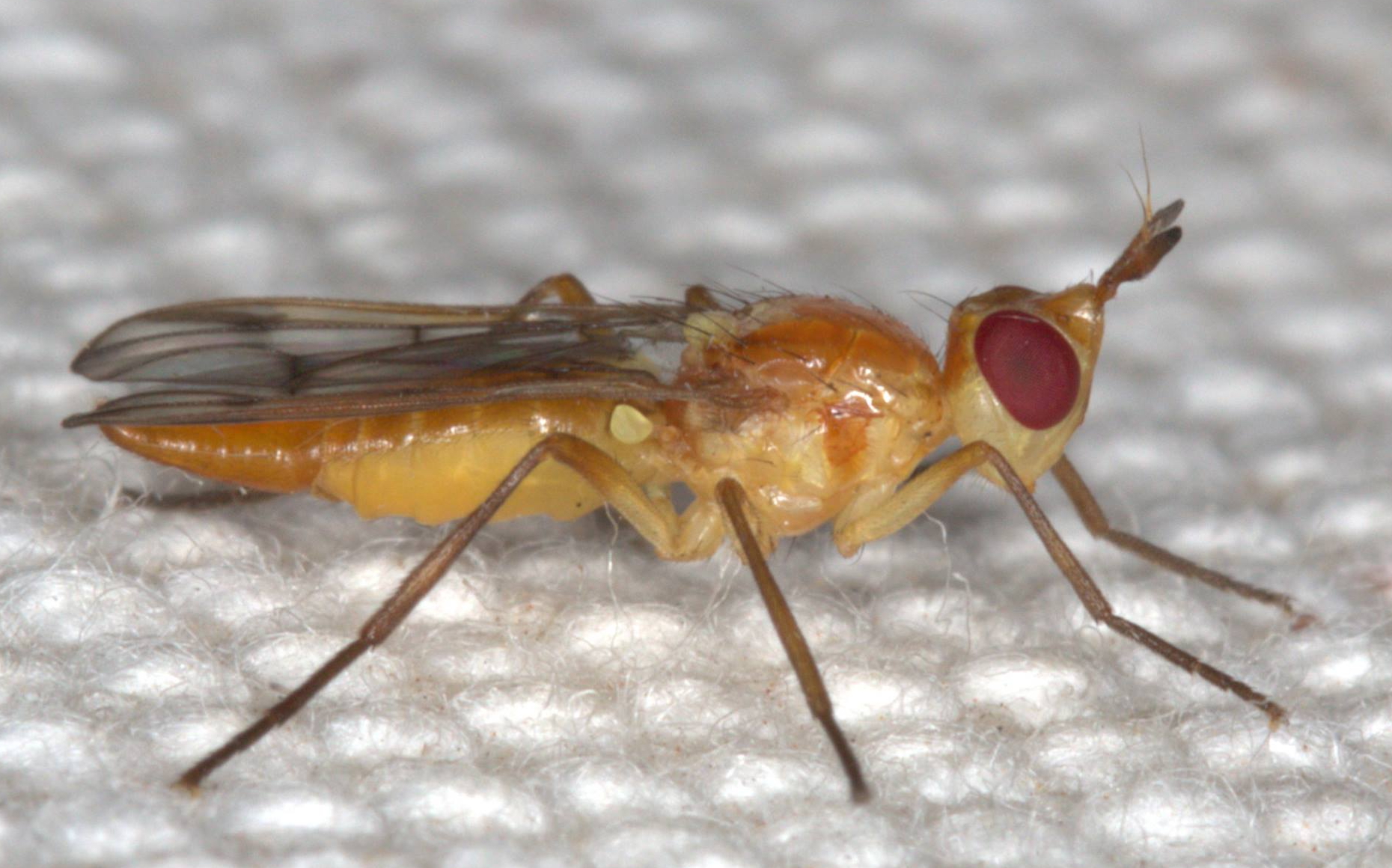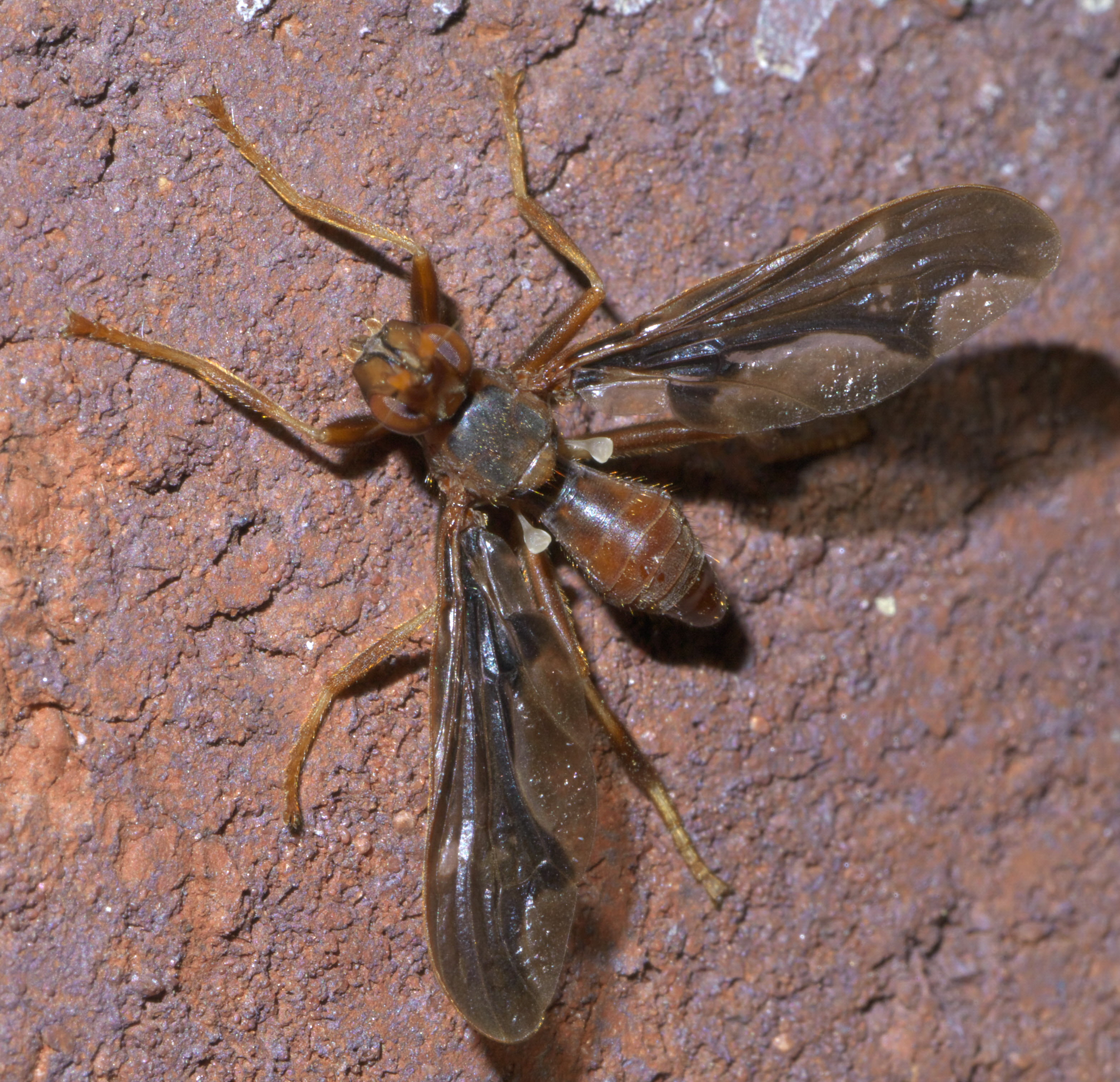|
Pyrgotidae
The Pyrgotidae are an unusual family of flies (Diptera), one of only two families of Cyclorrhapha that lack ocelli. Most species are "picture-winged" (i.e., have patterns of bands or spots on the wings), as is typical among the Tephritoidea, but unlike other tephritoids, they are endoparasitoids; the females pursue scarab beetles in flight, laying an egg on the beetle's back under the elytra where the beetle cannot reach it. The egg hatches and the fly larva enters the body cavity of the beetle, feeding and eventually killing the host before pupating. In the United States, some species of '' Pyrgota'' and '' Sphecomyiella'' can be quite common in areas where their host beetles (typically the genus ''Phyllophaga'', or "June beetles") are abundant. Like their host beetles, these flies are primarily nocturnal, and are often attracted to artificial lights. Genera *''Acropyrgota'' Hendel, 1914 *'' Adapsilia'' Waga, 1842 *'' Adapsona'' Paramonov, 1958 *'' Afropyrgota'' V. Korneyev, ... [...More Info...] [...Related Items...] OR: [Wikipedia] [Google] [Baidu] |
Pyrgotidae Diptera Dorsal Johan Heyns
The Pyrgotidae are an unusual family of flies (Diptera), one of only two families of Cyclorrhapha that lack ocelli. Most species are "picture-winged" (i.e., have patterns of bands or spots on the wings), as is typical among the Tephritoidea, but unlike other tephritoids, they are endoparasitoids; the females pursue scarab beetles in flight, laying an egg on the beetle's back under the elytra where the beetle cannot reach it. The egg hatches and the fly larva enters the body cavity of the beetle, feeding and eventually killing the host before pupating. In the United States, some species of '' Pyrgota'' and '' Sphecomyiella'' can be quite common in areas where their host beetles (typically the genus ''Phyllophaga'', or "June beetles") are abundant. Like their host beetles, these flies are primarily nocturnal, and are often attracted to artificial lights. Genera *''Acropyrgota'' Hendel, 1914 *'' Adapsilia'' Waga, 1842 *'' Adapsona'' Paramonov, 1958 *'' Afropyrgota'' V. Korneyev, ... [...More Info...] [...Related Items...] OR: [Wikipedia] [Google] [Baidu] |
Pyrgotidae Diptera Lateral Johan Heyns
The Pyrgotidae are an unusual family of flies (Diptera), one of only two families of Cyclorrhapha that lack ocelli. Most species are "picture-winged" (i.e., have patterns of bands or spots on the wings), as is typical among the Tephritoidea, but unlike other tephritoids, they are endoparasitoids; the females pursue scarab beetles in flight, laying an egg on the beetle's back under the elytra where the beetle cannot reach it. The egg hatches and the fly larva enters the body cavity of the beetle, feeding and eventually killing the host before pupating. In the United States, some species of '' Pyrgota'' and '' Sphecomyiella'' can be quite common in areas where their host beetles (typically the genus ''Phyllophaga'', or "June beetles") are abundant. Like their host beetles, these flies are primarily nocturnal, and are often attracted to artificial lights. Genera *''Acropyrgota'' Hendel, 1914 *'' Adapsilia'' Waga, 1842 *'' Adapsona'' Paramonov, 1958 *'' Afropyrgota'' V. Korneyev, ... [...More Info...] [...Related Items...] OR: [Wikipedia] [Google] [Baidu] |
Tephritoidea
The Tephritoidea are a superfamily of flies. It has over 7,800 species, the majority of them in family Tephritidae. The following families are included: * Ctenostylidae * Eurygnathomyiidae * Lonchaeidae - lance flies * Pallopteridae — flutter flies * Piophilidae — skippers * Platystomatidae — signal flies * Pyrgotidae * Richardiidae * Tephritidae — fruit flies * Ulidiidae (Otitidae) — picture-winged flies The Tachiniscinae, formerly ranked as the family Tachiniscidae, are now included in the Tephritidae. Description Tephritoidea are generally rather hairy flies with setae weakly differentiated. They have the following synapomorphies: male tergum 6 strongly reduced or absent; surstylus or medial surstylus with toothlike prensisetae (in Piophilidae only in one genus); female sterna 4-6 with anterior rodlike apodemes; female tergosternum 7 consisting of two portions, the anterior forming a tubular oviscape and the posterior consisting of two pairs of longitudinal taenia ... [...More Info...] [...Related Items...] OR: [Wikipedia] [Google] [Baidu] |
Boreothrinax
''Boreothrinax'' is a genus of flies in the family Pyrgotidae The Pyrgotidae are an unusual family of flies (Diptera), one of only two families of Cyclorrhapha that lack ocelli. Most species are "picture-winged" (i.e., have patterns of bands or spots on the wings), as is typical among the Tephritoidea, but .... Species *'' B. debilis'' ( Osten Sacken, 1877) *'' B. dichaetus'' Steyskal, 1978 *'' B. filiola'' ( Loew, 1876) *'' B. maculipennis'' ( Macquart, 1846) *'' B. shewelli'' Steyskal, 1978 References {{Taxonbar, from=Q19936518 Pyrgotidae Diptera of North America ... [...More Info...] [...Related Items...] OR: [Wikipedia] [Google] [Baidu] |
Acropyrgota
''Acropyrgota'' is a genus of flies in the family Pyrgotidae The Pyrgotidae are an unusual family of flies (Diptera), one of only two families of Cyclorrhapha that lack ocelli. Most species are "picture-winged" (i.e., have patterns of bands or spots on the wings), as is typical among the Tephritoidea, but .... Species *''A. cribripennis'' Bezzi, 1929 (Synonym of '' Cardiacera cribripennis'' ( Bezzi, 1929)) *'' A. flavescens'' Hendel, 1914 References {{Taxonbar, from=Q18107570 Pyrgotidae Diptera of Australasia Brachycera genera Taxa named by Friedrich Georg Hendel ... [...More Info...] [...Related Items...] OR: [Wikipedia] [Google] [Baidu] |
Campylocera
''Campylocera'' is a genus of flies in the family Pyrgotidae The Pyrgotidae are an unusual family of flies (Diptera), one of only two families of Cyclorrhapha that lack ocelli. Most species are "picture-winged" (i.e., have patterns of bands or spots on the wings), as is typical among the Tephritoidea, but .... Species References {{taxonbar, from=Q14683411 Pyrgotidae Diptera of Africa Taxa named by Pierre-Justin-Marie Macquart ... [...More Info...] [...Related Items...] OR: [Wikipedia] [Google] [Baidu] |
Clemaxia
''Clemaxia'' is a genus of flies in the family Pyrgotidae The Pyrgotidae are an unusual family of flies (Diptera), one of only two families of Cyclorrhapha that lack ocelli. Most species are "picture-winged" (i.e., have patterns of bands or spots on the wings), as is typical among the Tephritoidea, but .... Species *'' C. adolfifriderici'' Enderlein, 1942 *'' C. angustiangulata'' Enderlein, 1942 *'' C. angusticornis'' Enderlein, 1942 *'' C. angustipalpis'' Enderlein, 1942 *'' C. flaviventris'' Mayer, 1953 *'' C. gracilis'' ( Hendel, 1914) References {{Taxonbar, from=Q14683071 Pyrgotidae Diptera of Africa Brachycera genera Taxa named by Günther Enderlein ... [...More Info...] [...Related Items...] OR: [Wikipedia] [Google] [Baidu] |
Pyrgota
''Pyrgota'' is a genus of flies in the family Pyrgotidae The Pyrgotidae are an unusual family of flies (Diptera), one of only two families of Cyclorrhapha that lack ocelli. Most species are "picture-winged" (i.e., have patterns of bands or spots on the wings), as is typical among the Tephritoidea, but .... There are about 10 described species in ''Pyrgota''. Species These 10 species belong to the genus ''Pyrgota'': * '' Pyrgota dichaetus'' (Steyskal, 1978) * '' Pyrgota fenestrata'' (Macquart, 1851) * '' Pyrgota ilona'' Aczel, 1956 * '' Pyrgota longipes'' Hendel, 1908 * '' Pyrgota lugens'' Wulp, 1898 * '' Pyrgota maculipennis'' (Macquart, 1846) * '' Pyrgota nelsoni'' Kondratieff & Fitzgerald, 1993 * '' Pyrgota shewelli'' (Steyskal, 1978) * '' Pyrgota undata'' Wiedemann, 1830 (waved light fly) * '' Pyrgota valida'' (Harris, 1841) References Further reading * External links * Pyrgotidae Articles created by Qbugbot Schizophora genera {{Tephritoidea-stub ... [...More Info...] [...Related Items...] OR: [Wikipedia] [Google] [Baidu] |
Phyllophaga
''Phyllophaga'' is a very large genus (more than 900 species) of New World scarab beetles in the subfamily Melolonthinae. Common names for this genus and many other related genera in the subfamily Melolonthinae are May beetles, June bugs, and July beetles. They range in size from and are blackish or reddish-brown in colour, without prominent markings, and often rather hairy ventrally. These beetles are nocturnal, coming to lights in great numbers. The generic name is derived from the Greek words ''phyllon'' (φυλλον), which means "leaf", and ' (φαγος), which means "eater", with a plural ending. Lifecycle The lifecycle takes about one year. Females lay 60 to 75 eggs over a period of about two weeks in midsummer. The white egg at first is elliptical (1.5 mm by 2.1 mm) but becomes more spherical as the larva inside develops. These hatch into white grubs about 18 days after laying. The newly hatched larvae are 8 mm long and grow to a length around 40 mm ... [...More Info...] [...Related Items...] OR: [Wikipedia] [Google] [Baidu] |
Pierre-Justin-Marie Macquart
Pierre-Justin-Marie Macquart (8 April 1778 – 25 November 1855) was a French entomologist specialising in the study of Diptera. He worked on world species as well as European and described many new species. Biography Early years Macquart was born in Hazebrouck, France, in 1778 and died in Lille in 1855. He was interested in natural history from an early age due to his older brother who was an ornithologist and a Fellow of the Société de Sciences de l’Agriculture et des Arts de la Ville de Lille and whose bird collection became the foundation of the societies museum, the Musée d'Histoire Naturelle de Lille. A second brother founded a botanic garden with a collection of over 3000 species of plants. Macquart, too became interested in natural history. In 1796 he joined the staff of General Armand Samuel then campaigning in the French Revolutionary Wars: Campaigns of 1796, Revolutionary Wars. He was a secretary and draftsman. The general staff was stationed in Schwetzingen, th ... [...More Info...] [...Related Items...] OR: [Wikipedia] [Google] [Baidu] |



